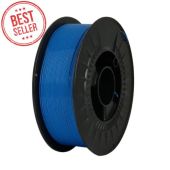Filament or Resin: Choosing the Right Material for Your 3D Prints
In 3D printing, material choice directly affects print quality, strength, cost, and application. Two main options dominate the market: filament and resin. Each serves different needs, and understanding their differences helps you avoid wasted time and resources.
At 3D Trček, we work daily with a wide range of thermoplastics. Our expertise covers not only extrusion but also advising clients on selecting the right filament or resin for their projects.
What Is Filament?
Filament is the material used in Fused Deposition Modeling (FDM) 3D printing. The printer melts and extrudes plastic through a nozzle, building the object layer by layer.
Types of Filament
There are many types of filament, each suited for different purposes:
- PLA: Easy to print, biodegradable, low warping, but brittle.
- PETG: Durable, chemically resistant, less brittle than PLA.
- ASA: Excellent UV and weather resistance, ideal for outdoor parts.
- TPU: Flexible and elastic, used for parts needing bendability.
- ABS: Strong and impact-resistant, but emits fumes when printing.
- Nylon, PC, PCTG, HIPS, PVA, Carbon Fiber, Flame Retardant, ESD, Silk, Wooden Filament: Specialized options for unique applications.
Filament Properties
Filament materials vary in strength, flexibility, print ease, and environmental resistance. For example:
- PLA is ideal for beginners due to its low printing temperature (190–220°C).
- PETG prints at 230–240°C and resists chemicals and impact.
- ASA requires 240–260°C but holds up well under UV exposure.
- TPU offers flexibility with Shore hardness from 85A to 95A.
What Is Resin?
Resin is used in Stereolithography (SLA), Digital Light Processing (DLP), and other vat polymerization methods. Instead of melting plastic, resin printers use light to cure liquid photopolymer layer by layer.
Resin Properties
Resin delivers extremely high detail, smooth surfaces, and sharp edges. This makes it ideal for:
- Miniatures
- Jewelry prototypes
- Dental molds
- High-precision engineering parts
Resin printers can achieve layer heights as low as 25 microns. However, handling resin requires more care due to potential skin irritation, odor, and the need for post-curing.
Filament vs Resin – Key Differences
Print Quality & Detail
Resin excels in fine detail. Models printed with resin feature smoother surfaces and sharper edges compared to filament. For intricate parts, resin outperforms any filament option.
Filament produces good functional parts but can show layer lines, especially on curved surfaces. Modern FDM printers reduce this effect, but resin still wins on detail.
Strength & Durability
Filament materials generally offer better strength for functional parts. Materials like PETG, ASA, TPU, and Nylon provide excellent mechanical properties suitable for load-bearing, outdoor, or flexible parts.
Resin parts are strong but more brittle, especially under sudden loads. Some advanced engineering resins exist, but they often cost significantly more.
Build Volume & Speed
Filament printers usually support larger build volumes. This makes filament better for producing big prototypes, mechanical parts, or jigs.
Resin printing is slower for large objects and limited by the vat size. However, resin printers can batch-print many small items efficiently.
Cost & Materials
Filament materials are generally cheaper and more widely available. A 1 kg spool of standard filament costs far less than 1 kg of resin.
Resin materials cost more due to specialized formulations and processing steps. Post-processing equipment (wash stations, UV curing units) adds to total expense.
Safety & Environment
Filament printing emits some ultrafine particles, especially with materials like ABS. Proper ventilation reduces exposure.
Resin requires careful handling with gloves and ventilation due to uncured photopolymers. Skin contact or inhalation should be avoided.
Both filament and resin are hygroscopic and require dry storage to prevent print failures. Airtight containers and desiccant packs help maintain material quality.
Which One Suits Your Project?
Your choice depends entirely on your application.
- Choose resin for jewelry models, miniatures, dental models, and parts requiring ultra-fine detail.
- Choose filament for functional prototypes, mechanical parts, outdoor components, and larger builds.
At 3D Trček, we specialize in filament solutions. Our range covers:
- PLA, PETG, ASA, TPU FLEX, ABS, Silk, Wooden, Nylon, PC, HIPS, PVA, Carbon Fiber,
- Flame Retardant, ESD, REFILL, and Litofan filaments.
Our team offers personal consultation to help you select the best filament type for your technical and commercial needs.
Tips for Best Results
Storing Filament
- Always store filament spools in airtight containers with desiccant packs.
- Use filament dryers or food dehydrators to remove absorbed moisture before printing.
- For hygroscopic materials like PETG, TPU, and Nylon, drying is often necessary after 24–48 hours of exposure.
Handling Resin
- Always wear gloves when handling liquid resin.
- Work in well-ventilated areas to minimize odor and exposure to vapors.
- Post-process prints with isopropyl alcohol washing and UV curing to fully harden and stabilize the part.
Pro Tip: For best results with resin, cure prints in direct sunlight or a UV chamber for 5–10 minutes after washing — this ensures maximum strength and clarity.
Why Choose 3D Trček
As a family-run company, 3D Trček offers:
- A wide range of thermoplastic filament options for FDM printing.
- Expert advice on material selection based on your specific application.
- In-house toolmaking, extrusion, and manufacturing expertise.
- Fast order processing, personal approach, and high-quality customer service.
We combine experience in extrusion technology with deep knowledge of filament properties to ensure your prints succeed.
Conclusion
Choosing between filament and resin 3D printing depends on your goals. Filament gives you versatility, durability, and larger build sizes, while resin offers unmatched precision and surface quality.
At 3D Trček, we provide not only top-grade filament but also expert support to help you achieve the best possible results. Explore our full material offer on our website 3dtrcek.com and contact us for personal consultation.
; ?>) Shop Filaments
Shop Filaments


Please complete your information below to login.
Bejelentkezés
Új fiók létrehozása